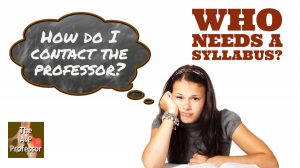Introduction (2 min)
Do students read the syllabus? What is a syllabus? (8 min)
Reading and raiding the syllabus (14.5 min)
First-day activities | A syllabus quiz? (18.5 min)
Basic elements of a syllabus (13.5 min)
More things to put in a syllabus (12 min)
Study strategies, extra topics, & FAQs (8.5 min)
Conclusion (1 min)
If you cannot see or activate the audio player click here.
Follow The A&P Professor on Twitter, Facebook, Blogger, Nuzzel, Tumblr, or Instagram!
There is a peculiar aesthetic pleasure in constructing the form of a syllabus, or a book of essays, or a course of lectures. Visions and shadows of people and ideas can be arranged and rearranged like stained-glass pieces in a window, or chessmen on a board.
A. S. Byatt
A. S. Byatt

(0:58) It's a BONUS episode, meaning that you get bonus minutes, meaning that it's a really, really long episode!
- How eccentric do you think Kevin is? Other listeners want to know! Really.
- 1-833-LION-DEN or 1-833-546-6336
- podcast@theAPprofessor.org
(3:03) Do students read the syllabus? Maybe half? It's the other half who drive us nuts. Wait! do we always read the directions before asking questions?
What is a syllabus? It can be different things, right? Why do administrators seem to love the syllabus so much?
- Recommended Twitter feed: @ReadTheSyllabus
- Please share the first tweet in my Twitter feed: @theAPprofessor.org
- That "empathy thing" I'm always harping on: Caring for Students Helps Them Succeed
- Is it syllabuses or syllabi? The answer is in a previous episode: 49 MORE Tricks for Retention & Success in Online Courses
(11:09) Some general considerations when designing a syllabus include make sure that students can both read the syllabus through, and raid the syllabus for key information when they need it. The key is simplicity and logic in syllabus design.
- READ and RAID your textbook (a link for students; explains the "read & raid principle" as applied to textbooks
- Storytelling is the Heart of Teaching A&P (the episode where I explain storytelling as a teaching technique)
- Utilize Clear Language (my take on simpler language to reach students)
- Temple Grandin, animal science professor and autism spokesperson; someone who "gets it" that we have to try to put our head inside their heads
- Recommended book: Animals in Translation
(25:36) Is it just "here's the syllabus; see ya next class"—or is it an engaged look at important syllabus elements? The first day of class is key to starting things off on a good foot. What I learned from Krista, Michael, and Richard—and my own sideways twist on those first steps. What about a syllabus quiz? Is that a good or bad idea?
- Krista Rompolski PhD @KristaRompolski
- Recommended teacher gear: Leather index card wallet or Index card wallet
- Engaging Students on the First Day of Class (my first-day syllabus activity; adapted from Michael Glasgow & Richard Faircloth; click through to download copies of my handouts)
- First Impressions: Activities for the First Day of Class (article from Faculty Focus)
- Why be honest? (about academic integrity)
- Student Understanding
- This is what I use for my Pre-A&P course, a self-paced onine refresher course
- My web-enhanced on-campus courses use a similar list
- The online quiz turns each item into a multichoice "I understand" or "I do not understand" test item
- A perfect score unlocks the next item in the LMS, thus making this a necessary gateway to access course activities
- Test Zero
- Reviews prior content and syllabus contents
- Start A&P 2 with a Final Exam (explains my Test Zero for A&P 2)
- Teaching For Long-Term Learning (episode in which I explain my Test Zero approach)

(44:24) What exactly goes into a syllabus? Who decides? What are the essentials? This isn't comprehensive, but it gets you
- How to Write a Syllabus (a great online guide from Cult of Pedagogy)
- HAPS Learning Outcomes - Human Anatomy and Physiology Society (HAPS membership is required to access them)
- Anatomy Core Syllabi (from the Anatomical Society; different flavors [undergrad med, nursing, pharmacy] membership not required to access them)
- LifeSciTRC Syllabus Resources (free samples of A&P syllabi & related resources)
(57:47) Frank O'Neill recommends video walk-throughs, which have the added benefit of letting students know that you really do care about them. Consider also a table contents, abstract/summary, and/or index if the syllabus is long. How about a disclaimer, some playful tidbits, and links to external resources. And make sure your supervisors know what's in your syllabus!
- Frank O'Neill @growgraymatter
- 7 Ways Video Can Enhance the Student Experience (video of Frank's live presentation, in which he addresses how to use a video walk-through of an A&P syllabus to give students a good first impression)
- Cumulative Testing Makes Learning Last (episode in which I discuss brief video walkthrough; click through for a link to more resources)
- Professors Are from Mars®, Students Are from Snickers®: How to Write and Deliver Humor in the Classroom and in Professional Presentations (recommended book)
- Playful & Serious Is the Perfect Combo for A&P (previous episode explaining the value of playfulness in the A&P course)
(1:09:38) Consider putting hyperlinks or URLs in the syllabus to take students to other resources. Consider linking to a FAQ page, wher you explain your rationals for doing things the way that you do them in your course.
- Additional links you may find useful
- Syllabus Resources for A&P (from the TAPP blog)
- Help Your A&P Students Get Off to a Good Start (from the TAPP blog)
- Academic integrity in A&P (from the TAPP blog)
- Some links that your students may find helpful:
- The A&P Student (Kevin's blog for A&P students; rich source of advice you can give your students; theAPstudent.org)
- Lion Den (Kevin's website with all kinds of study skills tips and resources for A&P students; LionDen.com)
- Medical Science Navigator (Margaret Thompson Reece’s website for helping A&P students; she offers mini-courses!)
- Getting a Good Start in your Anatomy & Physiology Course
- Why be honest? (about academic integrity)
- Why deadlines are important
- Is spelling important?
- Help significant others help you (getting busy students—especially returning learners—off to a great start)
- Get Your Head in the Game - 5 Tips for Success in Learning (metacognition for A&P students)
- 9 Proven Tricks for Reducing Test Anxiety (for A&P students)
(1:18:07) Final thoughts. Okay, no real thoughts. Just be glad you made it this far!
If the hyperlinks here are not active, go to TAPPradio.org to find the episode page.
- More details at the episode page.
- Transcript available at the script page.
- Listen to any episode on your Alexa device.
- Join The A&P Professor social network:
- Blog
- Twitter @theAPprofessor
- Facebook theAPprofessor
- Instagram theAPprofessor
- YouTube
Click here to listen to this episode—or access the detailed notes and transcript.


No comments:
Post a Comment